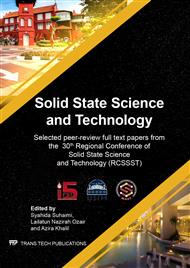[1]
J. Wei et al., Facile synthesis of thermo-responsive nanogels less than 50 nm in diameter via soap- and heat-free precipitation polymerization, J. Mater. Sci. 53(17) (2018) 12056-12064.
DOI: 10.1007/s10853-018-2495-x
Google Scholar
[2]
J. Khan, M. Siddiq, B. Akram, M. A. Ashraf, In-situ synthesis of CuO nanoparticles in P(NIPAM-co-AAA) microgel, structural characterization, catalytic and biological applications, Arab. J. Chem. 11(6) (2018) 897-909.
DOI: 10.1016/j.arabjc.2017.12.018
Google Scholar
[3]
R. Contreras-Ca, L. Schellkopf, C. Ferna, I. Pastoriza-Santos, J. Pe, M. Stamm, Effect of the cross-linking density on the thermoresponsive behavior of hollow PNIPAM microgels, Langmuir 31(3) (2015) 1142-1149.
DOI: 10.1021/la504176a
Google Scholar
[4]
A. K. Tucker, M. J. Stevens, Study of the polymer length dependence of the single chain transition temperature in syndiotactic Poly(N -isopropylacrylamide) oligomers in water, Macromolecules 45(16) (2012) 6697–6703.
DOI: 10.1021/ma300729z
Google Scholar
[5]
X. Lang, A.D. Patrick, B. Hammouda, M.J.A. Hore, Chain terminal group leads to distinct thermoresponsive behaviors of linear PNIPAM and polymer analogs, Polymer 145 (2018) 137-147.
DOI: 10.1016/j.polymer.2018.04.068
Google Scholar
[6]
A. Pica, G. Graziano, Hydrostatic pressure effect on PNIPAM cononsolvency in water-methanol solutions, Biophys. Chem. 231 (2017) 34–38.
DOI: 10.1016/j.bpc.2017.01.001
Google Scholar
[7]
M. Yang, K. Zhao, Cononsolvency of poly( N -isopropylacrylamide) in methanol aqueous solution-insight by dielectric spectroscopy, J. Polym. Sci. Part B Polym. Phys. 55(16) (2017) 1227–1234.
DOI: 10.1002/polb.24377
Google Scholar
[8]
K. Jain, R. Vedarajan, M. Watanabe, M. Ishikiriyama, N. Matsumi, Tunable LCST behavior of poly(N-isopropylacrylamide/ionic liquid) copolymers, J. Polym. Chem. 38(6) (2015) 6819-6825.
DOI: 10.1039/c5py00998g
Google Scholar
[9]
M. Kwok, T. Ngai, Emulsions stabilized by pH-responsive PNIPAM-based microgels: Effect of spatial distribution of functional carboxylic groups on the emulsion stability, J. Taiwan Inst. Chem. Eng. 92 (2018) 97-105.
DOI: 10.1016/j.jtice.2018.01.041
Google Scholar
[10]
A. Sood, Particle size distribution control in emulsion polymerization, J. of Appli. Polym. Sci. 92(5) (2004) 2884-2902.
DOI: 10.1002/app.20231
Google Scholar
[11]
L. C. Kröger, W. A. Kopp, K. Leonhard, Prediction of chain propagation rate constants of polymerization reactions in aqueous NIPAM/BIS and VCL/BIS systems, J. Phys. Chem. B 121(13) (2017) 2887-2895.
DOI: 10.1021/acs.jpcb.6b09147
Google Scholar
[12]
B. Sun, Y. Lin, P. Wu, Structure analysis of Poly(N-isopropylacrylamide) using near- infrared spectroscopy and generalized two-dimensional correlation infrared spectroscopy, J. Appli. Spectr. 61(7) (2007) 765-771.
DOI: 10.1366/000370207781393271
Google Scholar
[13]
D. A. Beattie, J. Addai-Mensah, A. Beaussart, G. V. Franks, K.-Y. Yeap, In situ particle film ATR FTIR spectroscopy of poly (N-isopropyl acrylamide) (PNIPAM) adsorption onto talc, Phys. Chem. Chem. Phys. 16(45) (2014) 25143-25151.
DOI: 10.1039/c4cp03161j
Google Scholar
[14]
Y. V. Pan, R. A. Wesley, R. Luginbuhl, D. D. Denton, B. D. Ratner, Plasma polymerized N-Isopropylacrylamide: Synthesis and characterization of a smart thermally responsive coating, J. Biomacromolecules 2(1) (2001) 32-36.
DOI: 10.1021/bm0000642
Google Scholar
[15]
M. Kurečič, M. Sfiligoj-Smole, K. Stana-Kleinschek, UV polymerization of poly (N-isopropylacrylamide) hydrogel, J. Mater. Tehnol. 46 (2012) 87–91.
Google Scholar
[16]
C. S. Chern, Emulsion polymerization mechanisms and kinetics, J. Prog. Polym. Sci., 31(5) (2006) 443-486.
Google Scholar
[17]
T. M. Riddick, Control of Colloid Stability through Zeta Potential: With a Closing Chapter on its Relationship to Cardiovascular Disease, Livingston, Pennsylvania, (1968).
Google Scholar
[18]
G. K. Batchelor, An Introduction to Fluid Dynamics, Cambridge University Press, Cambridge, (2002).
Google Scholar
[19]
E. H. N. Yong, K. Y. Tshai, I. C. C. Lim, S. S. Lim, Y. A. Nor, Y. Z. H. Y. Hashim, Electrospun linear uncrosslinked and crosslinked poly(N-isopropylacrylamide) hydrogel scaffolds, National Electrospinning Conference, Kuala Lumpur, (2018).
Google Scholar
[20]
C. A. Ribeiro, M. V. S. Martins, A. H. Bressiani, J. C. Bressiani, M. E. Leyva, A. A. A. de Queiroz, Electrochemical preparation and characterization of PNIPAM-HAp scaffolds for bone tissue engineering, J. Mater. Sci. Eng. C 81 (2017) 156–166.
DOI: 10.1016/j.msec.2017.07.048
Google Scholar
[21]
L. Ruiz-Rubio, V. Álvarez, E. Lizundia, J. L. Vilas, M. Rodríguez, and L. M. León, Influence of α-methyl substitutions on interpolymer complexes formation between poly(meth)acrylic acids and poly(N-isopropyl(meth)acrylamide)s, J. Colloid and Polym. Sci. 293(5) (2015) 1447–1455.
DOI: 10.1007/s00396-015-3529-4
Google Scholar


